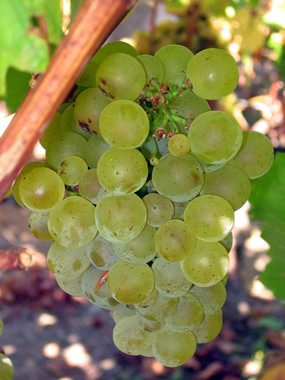If you happen to be vegetarian, wine could present a problem. Most people don’t realise that wines are usually made using animal-derived products. To clean the newly-made wine and remove cloudiness and small particles, a process called “fining” is used. This involves passing the wine though fining agents which might include gelatin (a protein made from boiling animal parts), isinglass (a substance made from dried fish bladders), chitosan (made from crustacean shells), casein (a protein found in milk) or egg albumen.
Much of this of course, is bad news for vegetarian wine drinkers and even worse news for vegans. Although there are alternative fining agents including carbon, Bentonite clay, limestone and silica gel, wine-makers rarely tell you what agents are used, so there’s usually no way of knowing. The freshly pressed grape juice is invariably contaminated with a variety of entrapped or liquefied insects, and for this reason it would be extremely difficult to produce a totally vegetarian or vegan wine.
 Sauvignon grapes on the vine.
Sauvignon grapes on the vine.
So, if I haven’t managed to put you off already, what’s tonight – red or white? And how do you match wines with vegetable dishes if you’re planning something special? At the risk of over-simplifying things, I’d suggest that with vegetarian food there are just two basic issues to consider, the “weight” of the food and the strength of its flavour. By weight, I mean the contrast between – for example – a light salad and a rich mushroom and vegetable stew in pastry. Vegetables on their own are light in weight and would be best accompanied by a dry white or even a dry rosé. But if you enjoy reds, you’ll have to find ways of increasing the weight if you want an attractive pairing.
Sauces can make a huge difference. For example, steamed broccoli or asparagus by itself is about as light as you can get, but add a rich palate-coating cheese sauce and you have something that can stand up to heavier wines. You can also make a dish heavier by adding wine-friendly ingredients such as beans, lentils, tomato sauces and aubergines (At this point, my ever-helpful spelling checker suggested “aborigines”). Another approach is to make your basic vegetables into a gratin with a crispy topping, adding almonds, hazelnuts or sweet vegetables like potatoes or roast red peppers, giving the food enough weight to match a red wine.
Then there’s flavour. A delicate wine will taste like water if you drink it with a spicy curry. In the same way, a big red will completely overpower an omelette. You can bump up the flavour of some bland dishes by adding spices such as cinnamon or nutmeg, grill or roast to produce richer flavours and use mushrooms, cheese or soy sauce. Spicy vegetarian dishes and curries tend to work best with fairly substantial off-dry wines. Many wine writers suggest Riesling or Gewürztraminer but both are expensive and very difficult to find in Thailand, so local Chenin Blanc could make a good alternative. Sweetness tends to temper the heat in fiery curries, so an off-dry white wine will subdue the heat and bring out the other flavours.
White wines (and some light-bodied reds) go well with vegetables in butter or cream sauces, peanut sauce, and yellow coconut curry. Fuller-bodied reds work well with tomato-based or chili-based sauces and Mexican-style food. Earthy mushrooms match Pinot Noir or Valpolicella. Tomatoes love Sangiovese, so a glass or two of Chianti is ideal with tomato-based pizza and pasta, especially if you use mushrooms and cheese to add a bit of richness and fat.
Terra Sur Sauvignon Blanc 2013 (white), Chile (Tesco-Lotus, Bt. 599)
Sauvignon Blanc’s acidity can make a good match for a wide range of cooking methods. It also works well with many raw dishes and salads. The herbal, grassy flavours of Sauvignon Blanc go naturally with leafy greens, raw tomatoes and Brussels sprouts. I read somewhere that Sherry makes a good partner for sprouts, which can be difficult to match with wine.
Terra Sur means “Land of the South” and the Sauvignons from Chile tend to be lighter, fruitier and less acidic than their French cousins. Both these wines are widely available and you might even find them a bit cheaper at some outlets. This one is a pale gold, with a splendid rich aroma of gooseberries, citrus fruits, spring-like grassiness and hints of fresh herbs. It’s a lovely light, dry wine with an attractive prickly sensation on the palate and there’s also a dash of citrus and a pleasing bite of mild acidity. The gooseberries are out in force on the palate and the citrusy finish seems to go on and on. This is a very well-crafted and refreshing young wine. At just 12.5% alcohol content it’s a lively easy-drinker that would also make a terrific apéritif.
Terra Sur Merlot 2012 (red), Chile (Tesco-Lotus, Bt. 599)
Rich vegetarian dishes go well with medium red wines with soft tannins, like a Merlot. This one is a very dark red, almost crimson colour. There’s an intriguing brambly and earthy aroma of spicy fruit, blackcurrants and dark plums. You might even pick up faint hints of minty chocolate way in the background. The aroma kept me occupied for several minutes, because it was so interesting. And I hope you always get your nose to work before you start drinking. It’s amazing the number of people who just don’t bother.
The wine is very dry and quite full-bodied, with an attractive velvety mouth-feel and satisfying tannins. It’s packed with damsons and plums and there’s a pleasing touch of woodiness with a long tangy finish. There’s rather an attractive edge to the taste too, which gives the wine a touch of assertiveness despite its soft mouth-feel.
This really is a splendid wine. Like many reds, it will probably show at its best with food. It would make an excellent partner for rich mushroom and cheese dishes and would almost certainly work well with tomato-based pasta too, if you discover that the dogs have finished off the Chianti.




